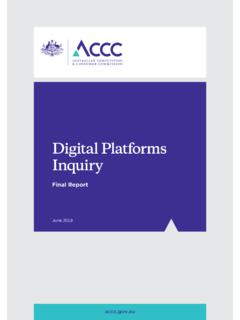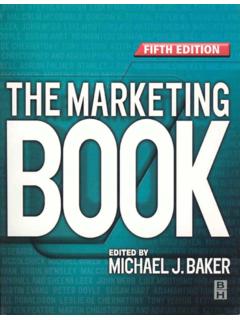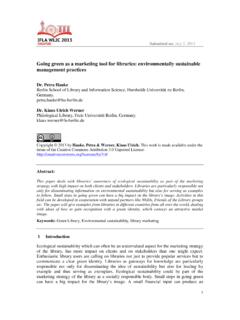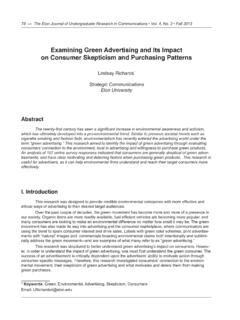Transcription of Green marketing and the Australian Consumer Law
1 Green marketing and the Australian Consumer LawAustralian Competition and Consumer Commission23 Marcus Clarke Street, Canberra, Australian Capital Territory, 2601 Commonwealth of Australia 2011 This work is copyright. Apart from any use as permitted under the Copyright Act 1968 no part may be reproduced by any process without permission from the Australian Competition and Consumer Commission. Requests and inquiries concerning reproduction and rights should be addressed to the Director Publishing, Australian Competition and Consumer Commission, GPO Box 3131 Canberra ACT noticeThis guideline is designed to give you basic information; it does not cover the whole of the Competition and Consumer Act and is not a substitute for professional , because it avoids legal language wherever possible, there may be generalisations about the application of the Act. Some of the provisions referred to have exceptions or important qualifi cations.
2 In most cases the particular circumstances of the conduct need to be taken into account when determining how the Act applies to that conduct. ISBN 978 1 921887 49 9 ACCC 03 1 Green marketing and the Australian Consumer Law 21. The Australian Consumer Law 3 What does the law say? 32. Making environmental claims 7 Principles to consider 8 Broad or unqualifi ed claims that can be problematic 12 Environmentally friendly or environmentally safe 12 Energy effi cient 13 Penalties and remedies for breaching the ACL 15 Avoiding a breach of the law 153. Key environmental effi ciency schemes 17 The Equipment Energy Effi ciency Program 17 Water Effi ciency Labelling and Standards (WELS) Scheme. 204. Checklist for marketers 22 Contacting the ACCC 251 Green marketing and the Australian Consumer LawIntroductionEnvironmental claims can be a powerful marketing tool.
3 Companies are increasingly using environmental claims in an attempt to differentiate themselves and their products from the competition. These claims come in a wide range of forms, including statements about environmental sustainability, recycling, energy and water effi ciency or impact on animals and the natural environment. Companies realise that consumers today have an increased awareness of the environmental impact that modern goods may have. Environmental claims are now relevant to a larger product range, from small household items such as nappies, toilet paper, cleaners and detergents to major whitegoods and appliances. Many consumers consider environmental claims, such as water or energy effi ciency, as a major factor when evaluating products to , it is essential that consumers are provided with accurate information in order to make informed which make environmental or Green claims should ensure that their claims are scientifi cally sound and appropriately substantiated.
4 Consumers are entitled to rely on any environmental claims you make and to expect these claims to be truthful. Not only is this good business practice; it is law. For the fi rst time, from 1 January 2011, Australian businesses and consumers have the same legal protections and expectations in relation to advertising and selling practices wherever they are in Australia. These are contained in the Australian Consumer Law (ACL), which is a schedule to the Competition and Consumer Act 2010. The ACL applies nationally and contains simple rules to ensure that businesses trade fairly with ACL states that businesses must not mislead or deceive consumers in any way, and it carries serious penalties for businesses that fail to meet these requirements. 2 Green marketing and the Australian Consumer LawGreen marketing and the Australian Consumer LawThe purpose of this guide is to educate businesses about their obligations under the ACL.
5 It aims to assist manufacturers, suppliers, advertisers and others to assess the strength of any environmental claims they make and to improve the accuracy and usefulness to consumers of their labelling, packaging and guide is divided into four parts:Part 1 examines the law the Australian Consumer Law and how it applies to environmental claims. Part 2 examines some of the broad principles you should consider when making environmental claims. This part provides a framework for examining your existing or upcoming advertising to ensure it complies with the law. It also includes a quick reference for some common and problematic claims. If your advertising contains any of these claims you should assess it against this part of the 3 examines some regulatory schemes, such as energy ratings and water effi ciency labelling. These schemes are particularly important for businesses in the appliance manufacturing or retailing 4 is a checklist for marketers against which you can check your claims to help identify any misleading marketing and the Australian Consumer Law1.
6 The Australian Consumer Law The ACL applies to all forms of marketing , including claims on packaging, labelling and in advertising and promotion across all mediums (print, TV, radio and internet). This means that any environmental claims you are considering need to be assessed against the requirements of the ACL. Failure to abide by the rules set out in the ACL can result in serious penalties. What does the law say?There are two main provisions in the ACL affecting the way you make environmental and deceptive conductThe ACL contains a broad prohibition of misleading and deceptive have an obligation not to engage in any conduct that is likely to mislead or deceive consumers. Note that the conduct only needs to be likely to mislead or deceive; it does not matter whether the conduct actually misled anyone, or whether the business intended to mislead if the conduct was likely to mislead or deceive, the ACL is contravened.
7 Broadly speaking, the conduct will be considered likely to mislead or deceive if there is a real or not remote possibility that members of its target audience have been misled. Plainly put, if part of the audience to which it is directed could be misled, there may be a contravention of the class of people likely to be affected by your advertising can be relatively wide. Therefore, it is important to carefully consider your audience when making environmental claims. Not all members of your audience will be especially educated, so claims should be clear and unambiguous. This also makes the use of technical or scientifi c jargon especially nature of the product is an important consideration. A Consumer may be unlikely to go through a lengthy decision-making process when buying a small household item, so you should consider the immediate impression made on them by your environmental claims.
8 4 Green marketing and the Australian Consumer LawMisleading conduct can include silence if in all the relevant circumstances there is an obligation to say something or if a reasonable expectation is created that matters will be disclosed, if they exist. For example, putting made from recycled material on a product when only a part of the product (such as the packaging) is made from recycled material could be misleading by silence. Misleading conduct can include predictions if the maker had no reasonable ground for making it, or if the prediction should have been qualifi ed and was not. A marketer making a statement about something that will happen in the future, such as by 2010 this product will be made entirely from wood pulp from plantation trees , could be found to be misleading if the marketer could not show there were reasonable grounds for making the statement at the time it was made.
9 Misleading conduct can also include advertising. The law will allow a degree of latitude when statements are clear puffery on the basis that most reasonable consumers are aware that some vague or generalised exaggeration occurs in advertising. For example, a claim such as world s best pies would likely be mere puffery. However, you should still exercise caution when making such claims, as you may be in breach of the law if consumers could be misled by your names could be misleading if they imply Green credentials that do not exist. For example, a business that promotes itself as an environmentally responsible energy company using a name such as Completely Clean & Green Energy may be at risk of misleading its customers if it in fact produces energy from an unclean or misleading representations In addition to the general rule against misleading or deceptive conduct, the ACL prohibits a variety of false or misleading representations about specifi c aspects of goods and services.
10 False and misleading representations are more serious than general misleading and deceptive conduct and, where criminal proceedings are taken, can carry serious penalties under the ACL including fi nes of up to $ million. There are two specifi c forms of prohibited misrepresentations that are especially relevant to environmental ACL requires that a business not falsely represent goods as being of a particular standard, quality, value, grade, composition, style or model or having a particular history or previous use. Put simply, goods must comply with any description that is provided in advertising or labelling. This is especially relevant to claims regarding recycled and recyclable content or the environmental impact of components used in the product, such as marketing and the Australian Consumer LawThe ACL also requires that a business not represent that goods or services have sponsorship, approval, performance characteristics, accessories, uses or benefi ts they do not have.



















